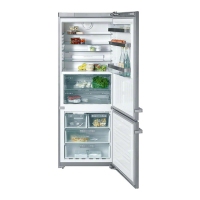
Do you have a question about the Miele KFN 8996 SDE ED-1 and is the answer not in the manual?
| Appliance placement | Freestanding |
|---|---|
| Built-in display | Yes |
| No Frost (fridge) | Yes |
| Multi-Airflow system (fridge) | Yes |
| Lamp type | LED |
| Number of vegetable drawers | 2 |
| Door balcony material | Glass |
| Egg balcony | Yes |
| Bottle rack | Yes |
| No Frost (freezer) | Yes |
| Ice cube tray | Yes |
| Fresh zone compartment | Yes |
| Number of Door Bins | 4 |
| Defrost System | Automatic |
| Temperature Zones | 3 |
| Ice Maker | No |
| Product colour | Stainless steel |
| Star rating | 4 |
| Width | 70 cm |
| Depth | 74 cm |
Information on how to dispose of packaging materials responsibly and safely.
Instructions for safely disposing of the old appliance to protect health and environment.
Identifies and describes the buttons and displays on the control panel.
Identifies and describes the various parts of the refrigerator and freezer sections.
Details about the Miele@home system as an optional accessory for remote monitoring.
Information on technical safety aspects, including coolant and installation risks.
Guidelines for the intended domestic use of the appliance and child safety.
Safety precautions related to electrical connections, earthing, and plugs.
Safety considerations for connecting to the mains water supply and ice cube maker.
Precautions for handling frozen food, ice cubes, and avoiding injury.
Warnings against storing explosive materials, using electrical equipment, and handling certain drinks.
Safety advice regarding defrosting sprays, door seals, lighting, and ventilation.
Guidance on operating the appliance within specified climate ranges to prevent damage.
Instructions for rendering the old appliance unusable and safe for disposal.
Advice on choosing an optimal installation location for energy efficiency.
Guidance on setting temperatures for energy saving with different thermostats.
Tips for reducing energy consumption through door usage and food storage.
Importance of timely defrosting to maintain energy efficiency.
Initial cleaning and preparation steps before operating the appliance.
Instructions for powering on the refrigerator and freezer sections.
Guidance on using the cool pack for maintaining temperature during power outages.
Procedures for turning off the refrigerator and freezer sections.
How to activate and deactivate the safety lock to prevent accidental changes.
Steps for safely switching off the appliance during extended absences like holidays.
Explains the meaning of symbols and temperatures shown on the external door display.
Instructions for modifying the brightness and contrast of the door display.
A comprehensive guide to the various symbols and their meanings on the door display.
Explains why correct temperatures are crucial for food preservation and reducing microorganism growth.
Recommended temperature setting for the refrigerator section and dynamic cooling.
Optimal temperature for freezing food and reasons for not refreezing thawed food.
How to adjust temperature settings for refrigerator and freezer sections.
Explains how temperatures are displayed and what flashing displays indicate.
Specifies adjustable temperature ranges and ambient temperature effects.
Instructions on how to change the brightness level of the temperature display.
Details about the alarm for high freezer temperature or open doors.
Explains the alarm triggered by a door being left open.
Notes that the alarm system is always active and requires no manual activation.
Procedures for manually silencing the alarm before set conditions are met.
How to use the Super cool function for rapid chilling of food and drinks.
Tips for freezing fresh food quickly to preserve quality and nutrients.
How to activate Super freeze before adding fresh food for optimal freezing.
Information on automatic and manual deactivation of the Super freeze function.
Explains how to use different temperature zones within the refrigerator for optimal storage.
Lists fruits, vegetables, and cheeses that should not be stored in the refrigerator.
Guidelines for packaging food to prevent smells, drying out, and cross-contamination.
Advice on storing fruits and vegetables, including gas emissions and reactions.
Best practices for storing meat to prevent bacterial growth and cross-contamination.
Instructions for adjusting the height of shelves, including handling glass-edge lighting.
Information on removing and repositioning the bottle rack.
How to adjust the bottle divider for secure bottle storage.
Instructions for removing and repositioning shelves within the refrigerator door.
Guidance on the appliance's capacity for freezing fresh food within a 24-hour period.
Tips for buying and storing pre-frozen food, including checking packaging and transport.
Advice on what foods are suitable and unsuitable for home freezing.
Instructions on seasoning, cooling hot foods, and portioning for freezing.
Recommendations for suitable and unsuitable packing materials for freezing food.
Guidance on using Super freeze before loading large quantities of food.
How to arrange food in drawers and on cold plates for quick freezing.
Method for freezing large food items by removing glass cold plates.
How to use the freezer calendar for tracking food storage times.
Using slide markers to record food type and freezing date.
Various methods for defrosting frozen food, with hygiene notes for poultry.
Best practices for rapidly cooling drinks using the Super cool function or freezer.
How to use the freezer tray for freezing small items individually.
Using the cool pack to maintain freezer temperature during power outages.
Steps to activate the automatic ice cube maker, including initial flushing.
How to maximize ice production and replace full ice cube drawers.
How to turn off the ice cube maker and use the drawer for extra storage.
How condensate and frost are automatically removed and drained in the refrigerator section.
Explanation of the 'Frost free' system for automatic defrosting of the freezer section.
Steps to take before cleaning, including switching off the appliance and removing food.
Instructions for cleaning the exterior, interior, accessories, and condensate channel.
Information on using a special microfibre cloth for cleaning various surfaces.
Step-by-step guide for cleaning the ice cube tray, including rotation for access.
Importance of cleaning ventilation gaps for energy efficiency and appliance performance.
How to clean door seals to maintain their integrity and prevent porosity.
Instructions for dusting the metal grille at the back of the appliance for energy efficiency.
Actions to take after cleaning, including replacing parts and switching on Super freeze.
Troubleshooting steps if the refrigerator or freezer sections are not getting cold.
Explains why the freezer door might be difficult to open after repeated use.
Solutions for when the temperature in the refrigerator or freezer section is too low.
Troubleshooting for the appliance switching on/off too frequently or for long periods.
Diagnosing and resolving issues when the alarm sounds and the freezer display flashes.
Understanding why a bar might be lit or flashing in the temperature displays.
Troubleshooting when one or more display areas on the door display are not illuminated.
Steps to take if the entire door display fails to light up.
Understanding and resetting indicators related to power cuts and temperature fluctuations.
Troubleshooting steps for when the ice cube maker cannot be switched on.
Steps to take if the ice cube maker is not producing ice cubes.
Identifying faults indicated by a flashing indicator light on the ice cube maker.
Troubleshooting when Super freeze/cool indicator lights are off but the function is active.
Resolving issues with the safety lock preventing the appliance from being switched off.
Troubleshooting steps if the interior or door lighting is not functioning.
Diagnosing and fixing a wet floor, typically due to a blocked drain hole.
Explains common noises like humming, gurgling, and clicking heard during normal operation.
Addresses noises like rattling and vibrating, and how to fix them.
Information on how to contact Miele Dealers or the Service Department for assistance.
Safety and regulatory requirements for connecting the appliance to the mains water supply.
Specifications for water quality and pressure (1.5-6 bar) for proper appliance function.
Step-by-step instructions for connecting the water inlet hose to the appliance.
Safety regulations and procedures for electrical connections in the UK.
Information on fuse replacement and safety covers for BS 1363 plugs.
Warnings against placing heat-emitting appliances on top or side-by-side with this appliance.
Advice on choosing a dry, well-ventilated room and avoiding direct sunlight or heat sources.
Details on the appliance's designed climate ranges and risks of operating outside them.
Importance of adequate ventilation at the back of the appliance and keeping gaps clear.
Instructions on how to adjust the appliance's feet for proper alignment using the supplied spanner.
Step-by-step process for removing the handles from the appliance doors.
Detailed instructions for safely removing the freezer door, including hinge parts.
Instructions for detaching the refrigerator door, including bearing block covers and cable.
Guidance on refitting hinge parts and bearing blocks for the appliance doors.
Steps for reassembling parts in the upper appliance door, including bearing bushes and pins.
Instructions for hanging and closing the freezer and refrigerator doors after hinging change.
How to secure the appliance doors to the bearing block and connect the cable plug.
Detailed steps for refitting handles, ensuring correct alignment to avoid seal damage.
Details on required clearances, ventilation gaps, and space for opening doors when building in.
Emphasizes keeping air inlet/outlet clear and dusting regularly for built-in appliances.
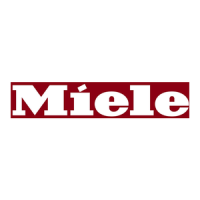


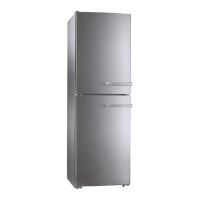
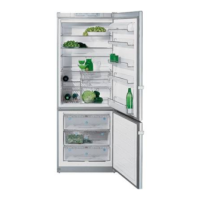

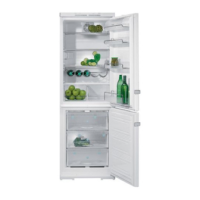



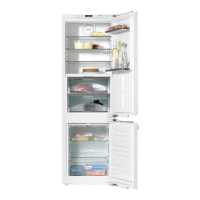
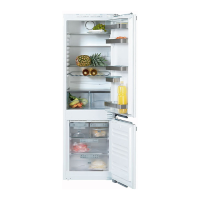
